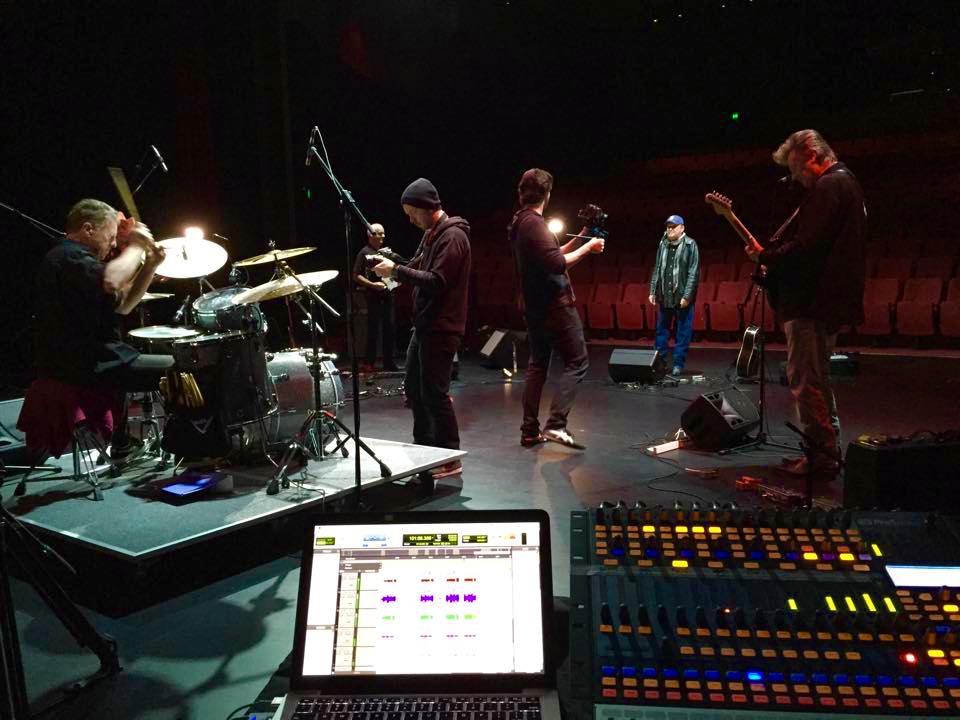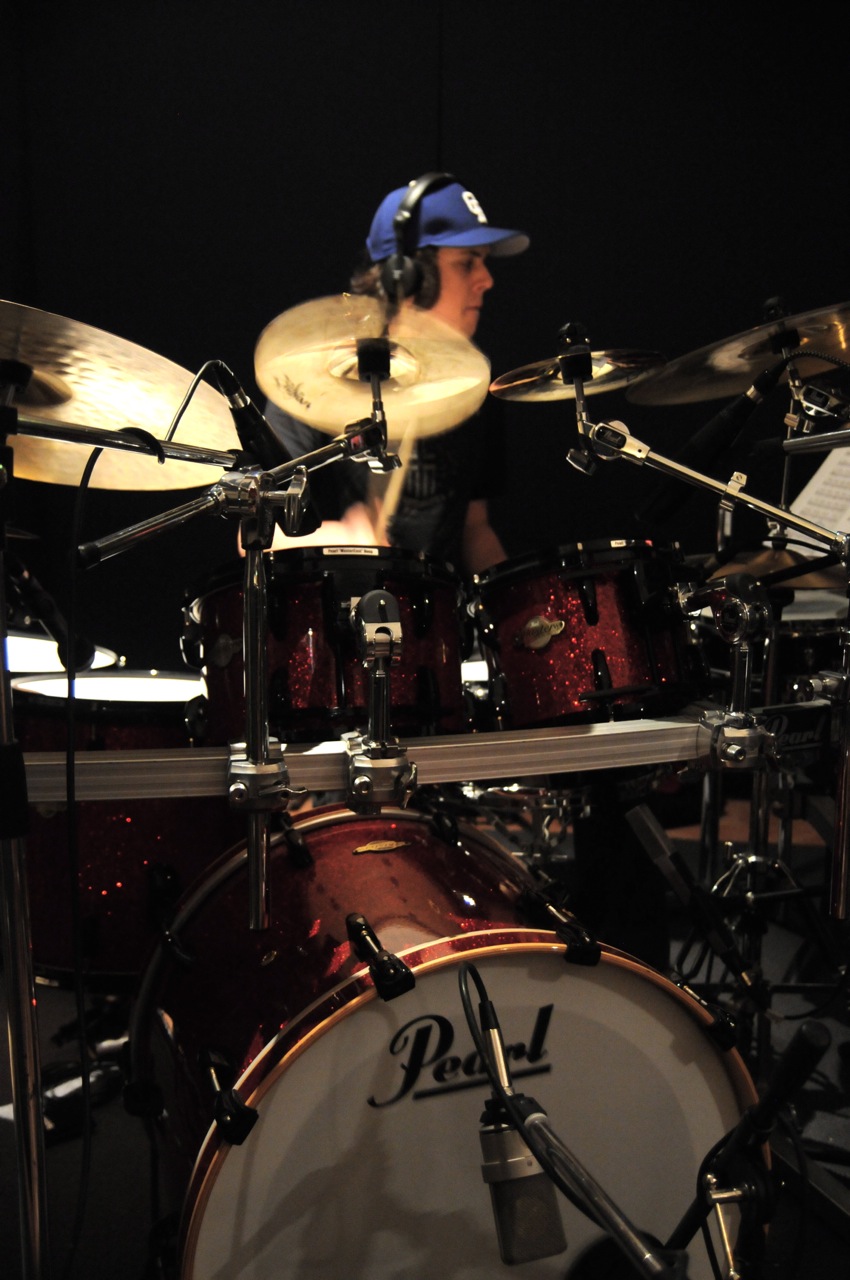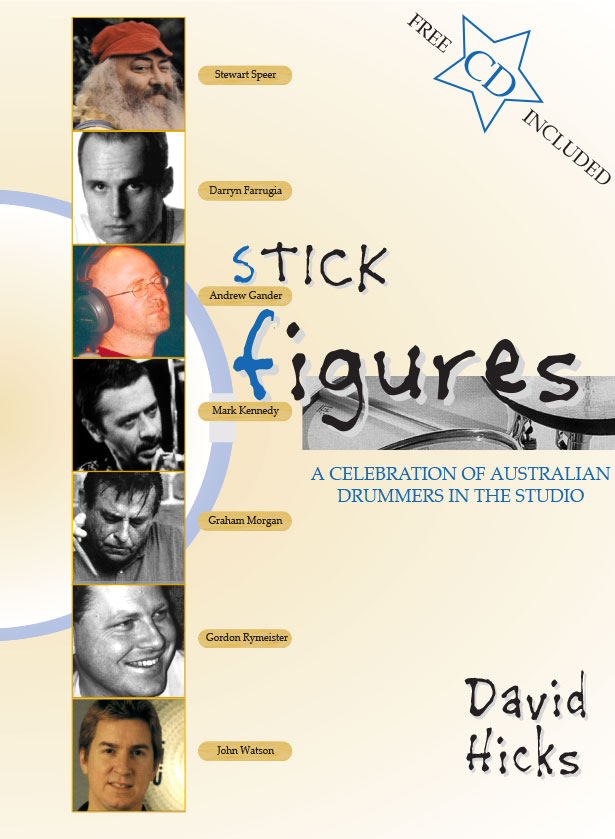Come with me inside actual recording sessions in this blog. I’m going to recollect a few of the moments which challenged me in some way, ultimately adding to my bag of skills (which, of course, is always being topped up). I hope the reader is educated and informed, as well as occasionally amused! There are lots of things that can go wrong just within a drum kit – squeaky pedal springs, loosening wing nuts, dropped/broken sticks, hi hat chokes, weird resonances, etc. etc. Many more studio anecdotes from other drummers can be found in the Stick Figures book, which can be ordered from this webpage.


I carted my trusty Slingerland drums and Zildjian cymbals (pictured above at a gig) up from Melbourne on the plane to this studio. This was to be my first professional album in a world – renowned studio: Festival Studios in Pyrmont, Sydney, in 1978. A studio which had seen all manner of Australian legends, including some of Johnny O’Keefe’s most successful recordings.

I had done some pre-production with singer-songwriter Paul O’Gorman, and his MD Doug Trevor, who hand-wrote clear drum charts with a calligraphy pen for me (which was the norm in those days).
After sound checking the drums (which the engineer then muffled with gaffer tape) and doing some takes along with the rhythm section and Paul’s guide vocal, it was decided that the sound wasn’t right, so they ended up moving me into a wooden ‘cabin’ with Perspex louvre windows, just big enough for my setup. What a different sound!
Also, Doug wasn’t happy with the amount of cymbal leakage into the drum mic’s, so he asked that I place strips of gaffer tape under all my crash cymbals. Again, not a sound I was used to! You can hear in the intro quite clearly how short the crash sustain time now was. I was quite un-nerved by this change in my sound. To me, although it made everything clearer and easier to place in the mix, it was too dry, lacking tone and expression. I was too green to speak up, and just had to get on with many more takes until the team were happy with one.
This was another aspect I had not encountered – being thoroughly prepared, I had done what I thought were good takes in the first few instances, but there must have been something that the production team were not happy with. It’s challenging to stay fresh after multiple takes!! We didn’t record to a click, but Doug would often give us a guide click over the headphones, we would play a section to it, then he’d switch it off and I would count in from the start.
A couple of times we might have done a ‘drop-in’ if someone had made a mistake. For those who don’t know, a drop-in is where you all play along with what’s already recorded, up to the start of the re-recording section and the engineer starts recording when everyone reaches the entry of that section. The challenge for a drummer here is to always play with the same intensity and tempo, so that there is no discernible difference between the old recorded part and the newly re-recorded section.
This session was also a learning curve for me, as I found out what ‘noise gates’ do. It’s worth considering, as we think about the dry studio sounds in fashion during the 1970’s, that radio consisted of AM only, with FM arriving in Australia later. Crafting a record that sounded equally good on a vinyl stereo as on an AM radio station was quite an art. Through use of noise gates, compression and gaffa tape, drums were made to sound as dry as possible.
At any rate, I was proud of my performances on the album, and got to be creative at times, such as the track “Jacqueline”, where I made a suggestion to add ‘thigh slaps’ as a non-invasive percussion track (inspired by Buddy Holly’s “Every Day”). It worked!
The single from the album, “Ride,Ride America” charted at 40 on the Australian charts.
A Home Recording Tip –
Digital aficionados will be familiar with this situation – what do you do when you’re halfway through recording a take and the guide track disappears in your headphones? Stop? Wrong! Keep playing! I did during a home recording, hoping the computer would sort itself out…and eight bars later, it did, back into action! I was relieved that I had concentrated on keeping the time steady, so when the click track resumed I was in exactly the right place. Of course anyone can practise this by programming a metronome to go silent for some bars, then resume. It’s also a great way to practise fills, to avoid rushing them, as many drummers do.
 (DAVID0079, http://www.umbrellaent.com.au)
(DAVID0079, http://www.umbrellaent.com.au)
Armstrongs Studios, Melbourne, 2002. Max Merritt has snuck in to the studio with his regular band between his tour dates, to put down some new songs for a planned DVD release.
We run a medium-tempo rocker called “Candy Row” a few times, but can’t capture the magic of our live performances. So we move on to record some other songs. Later that afternoon we decide to have one more try at “Candy Row”. Having smacked the Pearl Masters kit (and Zildjian cymbals) pretty hard for several hours, I’m a little fatigued….but sometimes one plays looser and more freely when a bit tired.
We get three quarters of the way through the song, when at the moment of a one-bar stop, I drop my left stick. With only the repeat choruses left to play, I soldier on (remember the session creed – don’t stop when something goes wrong).
I couldn’t reach my spare sticks because they were hanging on the side of my floor tom, and I needed to keep playing with my right hand. No-one could see me in the room because of the sound baffles surrounding me.
I didn’t admit anything as we had a listen to the playback in the control room. No one even noticed!! Astute listeners might notice that the sustained chord at the very end seems a little underdone in the drum department…because I still only had one stick with which to create a lot of sound.
Everyone was happy with the performance. That’s when I explained what had happened, and showed them they could just hear the noise of a stick knocking a stand as it fell during the stop bar. It was funny, and Max henceforth dubbed me ‘One-stick Hicks’!


Major Label Shenanigans
In 1983 I was a member of an original band called The Kevins, who were signed to a major record label. We were recording our new songs at Richmond Recorders, with guitarist/producer Martin Armiger at the helm. Since the fashion at the time was to get the cleanest separated sounds possible (again, noise gates were employed to keep everything clean), Martin decided I should record the parts of the kit separately. That was just plain weird to me, but since Mushroom Records were paying the bills, and employed him as producer, I did as he asked. So, first came some passes playing kick and snare. Next, hi-hat. Then tom fills. Finally, cymbal crashes. Not surprisingly, the result lacked feel, being rather drum-machine-like, and I missed hearing the nuances like sympathetic resonance of all the drums, or snare buzz in the background. I think there’s a reason this method hasn’t become the norm.

If you want to take on a personal challenge, try recording yourself, part by part, and see if it stacks up against the same kit part played live in one pass. Taking a wider view, a question to consider:- can anyone programming a digital drum track equal or better the feel and composition of a live performance by an experienced drummer?
Last Man Up
Have you ever been the last instrument to be added to a song? In 1998, the Whirling Furphies found themselves ‘between drummers’, so went ahead with recording their songs, to a click, until a drummer turned up. By the time I joined the band, all the songs were ‘finished’. My brief was to over dub drums in George Butrumlis’ lounge room ‘studio’, using my Roland TD7 (electronic drum kit), Ludwig Black Beauty snare and Paiste cymbals. The liner notes state “Some of the techniques used to record this CD were frighteningly experimental”!

For me, the main challenge was:- the click was in the middle of the beat, the bass was behind the click, and most of the rest of the instrumentation plus vocals were ahead of the click. Of course, listening without the click sounded kind of OK, as most bands have a little give and take, rhythmically-speaking. But I now had the job of making my part sit with all those disparate parts. I think my brain kind of split the difference between everything, so I played a sort of ‘average’ in my tempo. It seemed to work, but was mentally fatiguing! One of those situations which, although unusual, one has to deal with. From then on, I had increased confidence that I could adapt my playing, whatever the circumstances.
When something unexpected happens on live national TV
https://www.youtube.com/watch?v=LiFrG9jG_LA
During 1985 I had the pleasure of gigging with Venetta Fields’ band “Taxi”, which included a couple of live TV appearances on the national program “Hey Hey, It’s Saturday”. At this time I was playing Sonor drums and Zildjian cymbals. This song, “Happiness”, started with a rubato section, with my entry at 0:54. You’ll hear a sizzling sound at this point, which was caused by a boom mic not being tightened enough; as I hit the crash cymbal on my left, the boom fell down, bringing the mic to rest on to that crash cymbal! As you might see in the wider picture, during the first few bars I wrestle the offending boom away with my left hand (whilst continuing the groove with my right). The boom can be seen later in one of my close-ups pointing down to the floor to my left. A crew member re-positioned it at the 1:50 point. Once again, the lesson here is to stay cool, keep playing and hope to survive without calamity, which I managed. Another lesson learned is that elevated rostrums may move up and down with the motion of playing, which this one did, and contributed to the mic boom collapse.


